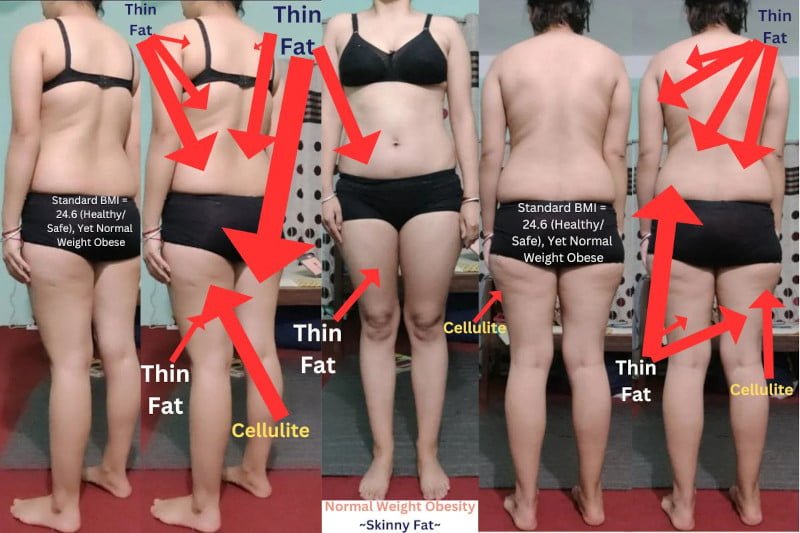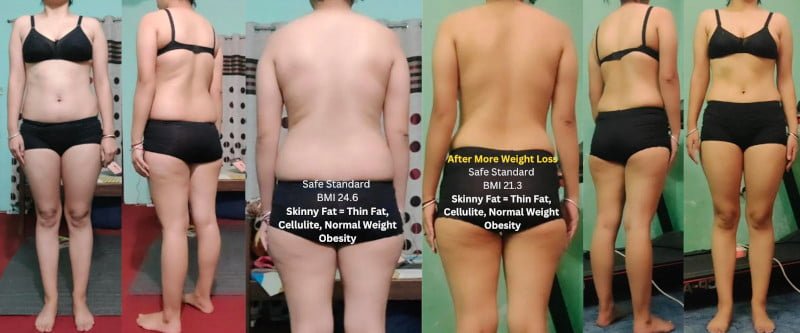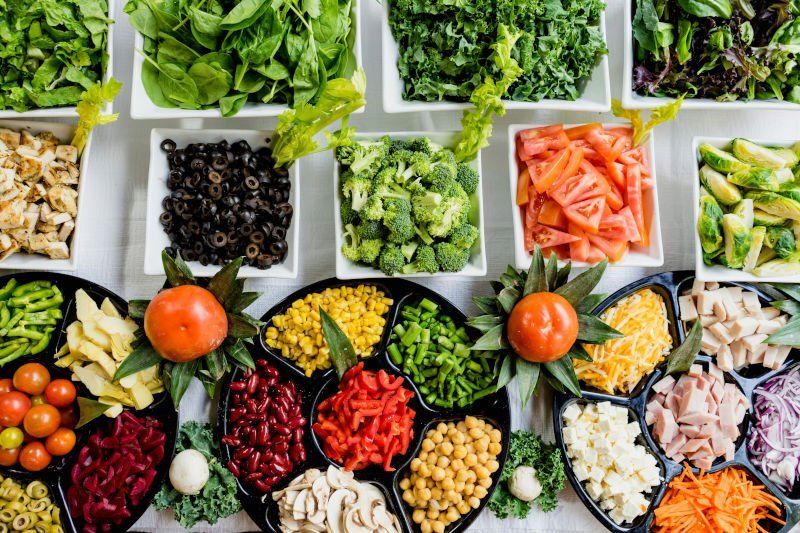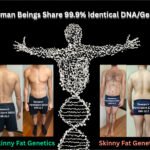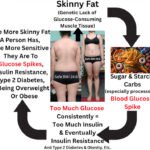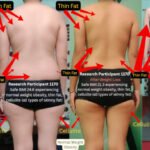Skinny Fat Genetics, Race DNA, and Muscle Tissue
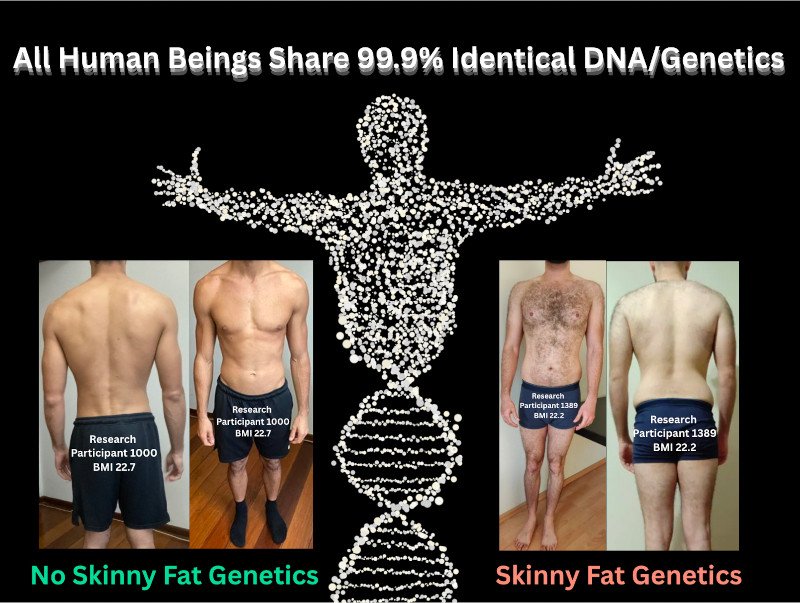
All human beings share 99.9% identical DNA/genetics (1, 2, 3, 4, 5, 6, 7). Thus, only about 0.1% of the estimated 3.2 billion DNA base pairs that make up the human genome differ between any two people. Potential genetic phenotype differences include physical traits — skin color, hair color & texture, eye color, height, intelligence, foot size, hand size, genital size, breast size, facial features, body composition (muscle, skinny fat, regular white/yellow fat), etc. — along with disease susceptibility, no less.
How real are skinny fat genetics? What are known variations in terms of race DNA, specifically developed genetic muscle tissue/fibers, or the lack of (skinny fat)? Are some races more prone to experiencing skinny fat? Is one biological gender — male or female — more prone to experiencing skinny fat?
Skinny Fat Genetics, Race DNA, and Muscle Tissue (Fibers)
All cultures, races, and genders genetically experience skinny fat. Because skinny fat science is so young, the current data is limited. Estimates indicate that roughly 2/3rds (8) of the population are experiencing some degree of skinny fat (underdeveloped genetic muscle tissue). Individual race DNA data roughly indicates that a lack of skeletal muscle tissue (skinny fat) among Asian people (9, 10, 11, 12), especially people from India, is more prominent when compared to White people (Caucasians).

Whereas, compared to Black people (13, 14, 15, 16), Asian, Hispanic, and White people experience less skeletal muscle tissue and likely more skinny fat.

However, as mentioned, all of this data remains incomplete and requires more scientific research. Our Skinny Fat MRI Study (17) will vastly improve the scientific data and give medical doctors the first-ever official way to diagnose skinny fat.
Of course, diet, exercise, and lifestyle directly influence skeletal muscle, at least. However, how much genetic muscle each person has is determined at or around birth (18) including muscle fiber ratio. Muscle fiber ratio determines how easy or how hard it is for each person to add muscle mass and maintain it.
The more skinny fat (lack of genetic muscle) a person is experiencing, and the less optimal their muscle fiber ratio, the harder it is to add muscle mass to reduce skinny fat. And, the harder it is to maintain any added muscle mass to maintain skinny fat reduction.
Biological Gender – Skinny Fat Genetics & Muscle Tissue
As for gender, biologically, women tend to naturally (genetically) have less (19, 20, 21, 22) genetic muscle tissue than men, and likely more skinny fat (thin fat and/or cellulite (23, 17)).

It is estimated that 80%+ women (24, 25, 26) are experiencing cellulite, but only roughly 10% of men. As well, women typically have more (27, 28, 29, 30, 31, 32, 22) regular white/yellow body fat (32), which directly affects metabolism (33) along with diet (34), exercise (35), lifestyle (36), and skinny fat (37)(if you are genetically experiencing it).
The Scientific Health Quizzes were developed to help you scientifically understand your unique genetic body composition (including any skinny fat) in relation to metabolism, diet, exercise, and lifestyle. Free options are available.
Skinny Fat Female with Low BMI – Ask A Skinny Fat Question
References
- National Human Genome Research Institute. Genetics vs. Genomics Fact Sheet, September 7, 2018. https://www.genome.gov/about-genomics/fact-sheets/Genetics-vs-Genomics
- National Human Genome Research Institute. Base Pair, June 14, 2025, Sarah A. Bates, M.S., M.A. https://www.genome.gov/genetics-glossary/Base-Pair#:~:text=One%20copy%20of%20the%20human,or%20across%20an%20entire%20genome.
- American Academy of Arts & Sciences: Unequal by nature: a geneticist’s perspective on human differences, Winter 2002, James Franklin Crow. https://www.amacad.org/publication/daedalus/unequal-nature-geneticists-perspective-human-differences
- NIH, National Library of Medicine – National Center for Biotechnology Information: Human gene and disease associations for clinical‐genomics and precision medicine research, May 3, 2020, Zeeshan Ahmed, Saman Zeesh, Dinesh Mendhe, and XinQi Dong. https://pmc.ncbi.nlm.nih.gov/articles/PMC7240856/
- NIH, National Library of Medicine – National Center for Biotechnology Information: Mapping and Sequencing the Human Genome, 1988. https://www.ncbi.nlm.nih.gov/books/NBK218247/
- Wikipedia: Base pair. https://en.wikipedia.org/wiki/Base_pair
- Nature, Education: DNA Sequencing Technologies Key to the Human Genome Project, 2008, Heidi Chial, Ph.D. https://www.nature.com/scitable/topicpage/dna-sequencing-technologies-key-to-the-human-828/
- Fellow One Research: Body Type Science Research Data. https://www.fellowone.com/category/fellow-one-research/the-four-body-types/body-type-science/research-data/
- ResearchGate: Evidence for low androgenicity among Indian (South Asian) men, November 2013, Thruchandurai Rajan (University of Connecticut), Jane E Kerstetter (University of Connecticut), Richard Feinn (Quinnipiac University) and Anne Kenny (UConn Health Center). https://www.researchgate.net/publication/258425336_Evidence_for_low_androgenicity_among_Indian_South_Asian_men
- NIH, National Library of Medicine: Thin Fat Obesity: The Tropical Phenotype of Obesity, March 2021, Nitin Kapoor, MBBS, MD. https://www.ncbi.nlm.nih.gov/books/NBK568563/
- NIH, National Library of Medicine: Less favorable body composition and adipokines in South Asians compared with other US ethnic groups: results from the MASALA and MESA studies, December 8, 2015, A D Shah, N R Kandula, F Lin, M A Allison, J Carr, D Herrington, K Liu, and A M Kanaya. https://pubmed.ncbi.nlm.nih.gov/26499444/
- ScienceDirect: Beyond BMI: Exploring obesity trends in the south Asian region, March 2025, Volume 13, 100156, Musarrat Riaz and Sidrah Lodhi. https://www.sciencedirect.com/science/article/pii/S2667368124000585
- NIH, National Library of Medicine: Ethnicity-Related Skeletal Muscle Differences Across the Lifespan, January 1, 2011, Analiza M Silva, Wei Shen, Moonseong Heo, Dympna Gallagher, Zimian Wang, Luis B Sardinha, and Steven B Heymsfield. https://pmc.ncbi.nlm.nih.gov/articles/PMC2795070/
- NIH, National Library of Medicine: Density of lean body mass is greater in blacks than in whites, June 1984, J E Schutte, E J Townsend, J Hugg, R F Shoup, R M Malina, and C G Blomqvist. https://pubmed.ncbi.nlm.nih.gov/6735823/
- ScienceDirect: Measures of body composition in blacks and whites: a comparative review, June 2000, Volume 71, Issue 6, Pages 1392-1402, Dale R Wagner and Vivian H Heyward. https://www.sciencedirect.com/science/article/pii/S0002916523071782
- American Journal of Clinical Nutrition: Body-composition differences between African American and white women: relation to resting energy requirements, May 2004, Volume 79, Issue 5p780-786, Alfredo Jones, Jr., Wei Shen, Marie-Pierre St-Onge, Dympna Gallagher, Stanley Heshka, ZiMian Wang, and Steven B Heymsfield. https://ajcn.nutrition.org/article/S0002-9165(22)03919-3/fulltext
- Skinny Fat Science: Scientific Skinny Fat MRI Study – Proving What Skinny Fat Is, March 26, 2025. https://skinnyfat.fellowone.com/skinny-fat-science/scientific-skinny-fat-mri-study-proving-what-skinny-fat-is/
- Skinny Fat Science: Is Muscle/Mass Genetic and How Does It Affect Skinny Fat?, November 20, 2025, https://skinnyfat.fellowone.com/skinny-fat-science/is-muscle-mass-genetic-and-how-does-it-affect-skinny-fat/
- American Physiological Society, Journal of Applied Physiology: Skeletal muscle mass and distribution in 468 men and women aged 18–88 yr, July 1, 2000, Ian Janssen, Steven B. Heymsfield, ZiMian Wang, and Robert Ross. https://journals.physiology.org/doi/full/10.1152/jappl.2000.89.1.81
- NIH, National Library of Medicine: Sex-Based Differences in Skeletal Muscle Kinetics and Fiber-Type Composition, January 2015, K M Haizlip, B C Harrison, and L A Leinwand. https://pmc.ncbi.nlm.nih.gov/articles/PMC4285578/
- NIH, National Library of Medicine: A Comparison between Male and Female Athletes in Relative Strength and Power Performances, February 9, 2021, Sandro Bartolomei, Giuseppe Grillone, Rocco Di Michele, and Matteo Cortesi. https://pmc.ncbi.nlm.nih.gov/articles/PMC7930971/
- BioMed Central, Biology of Sex Differences: Sex differences in body composition and association with cardiometabolic risk, June 27, 2018, Melanie Schorr, Laura E. Dichtel, Anu V. Gerweck, Ruben D. Valera, Martin Torriani, Karen K. Miller, and Miriam A. Bredella. https://bsd.biomedcentral.com/articles/10.1186/s13293-018-0189-3
- Skinny Fat Science: What Is Skinny Fat?, July 26, 2024. https://skinnyfat.fellowone.com/skinny-fat-science/what-is-skinny-fat/
- Cleveland Clinic: Cellulite, October 28, 2021. https://my.clevelandclinic.org/health/diseases/17694-cellulite
- MedicalNewsToday: Everything you need to know about cellulite, November 13, 2023, Peter Crosta (Medically reviewed by Catherine Hannan, M.D., Plastic Surgery). https://www.medicalnewstoday.com/articles/149465
- ScienceDaily: Why Do Women Store Fat Differently From Men?, March 4, 2009, University of New South Wales. https://www.sciencedaily.com/releases/2009/03/090302115755.htm
- NIH, National Library of Medicine: Determinants of body fat distribution in humans may provide insight about obesity-related health risks, August 10, 2018, Aaron P Frank, Roberta de Souza Santos, Biff F Palmer, and Deborah J Clegg. https://pmc.ncbi.nlm.nih.gov/articles/PMC6795075/
- NIH, National Library of Medicine: Gender differences in fat metabolism, November 2001, E Blaak. https://pubmed.ncbi.nlm.nih.gov/11706283/
- University of New Mexico: Gender Differences in Fat Metabolism, Chantal Vella, M.S. and Len Kravitz, Ph.D. https://www.unm.edu/~lkravitz/Article%20folder/genderdifferences.html
- NIH, National Library of Medicine: Sex differences in human adipose tissues – the biology of pear shape, May 31, 2012, Kalypso Karastergiou, Steven R Smith, Andrew S Greenberg, and Susan K Fried. https://pmc.ncbi.nlm.nih.gov/articles/PMC3411490/
- Skinny Fat Science: Is 20% Body Fat Skinny Fat?, May 14, 2025. https://skinnyfat.fellowone.com/skinny-fat-science/is-20-body-fat-skinny-fat/
- Skinny Fat Science: Are Regular Fat and Skinny Fat the Same Thing?, August 28, 2024. https://skinnyfat.fellowone.com/skinny-fat-science/are-regular-fat-and-skinny-fat-the-same-thing/
- Skinny Fat Science: How Metabolism Affects Skinny Fat, August 7, 2024. https://skinnyfat.fellowone.com/skinny-fat-science/how-skinny-fat-affects-metabolism/
- Skinny Fat Science: The Best Skinny Fat Diet, According to Science, July 29, 2024. https://skinnyfat.fellowone.com/skinny-fat-science/the-best-skinny-fat-diet-according-to-science/
- Skinny Fat Science: The Best Skinny Fat Exercise, According to Science, August 2, 2024. https://skinnyfat.fellowone.com/skinny-fat-science/the-best-skinny-fat-exercise-according-to-science/
- Skinny Fat Science: The Best Skinny Fat Lifestyle, According to Science, August 14, 2024. https://skinnyfat.fellowone.com/skinny-fat-science/the-best-skinny-fat-lifestyle-according-to-science/
- Skinny Fat Science: Skinny Fat & Insulin Resistance, June 4, 2025. https://skinnyfat.fellowone.com/skinny-fat-science/skinny-fat-insulin-resistance/

